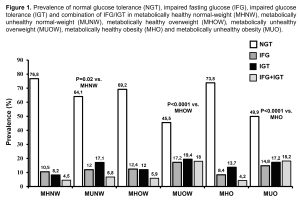Background: The prevalence of impaired fasting glucose (IFG), impaired glucose tolerance (IGT) or IFG+IGT prediabetic conditions in individuals with normal-weight, overweight or obesity according to metabolically healthy and unhealthy phenotypes is unknown. In this study, we utilized estimated glucose disposal rate (eGDR) index of insulin sensitivity, which is based on the readily available clinical parameters i.e. waist circumference, hypertension, and HbA1c to categorize metabolically healthy and unhealthy phenotypes, and determine the prevalence of prediabetic conditions. Methods: Non-diabetic individuals (n=2201) were stratified into quartiles of insulin-sensitivity based on eGDR index. According to BMI, individuals in the upper quartiles of eGDR were defined as having metabolically healthy normal-weight (MHNW), overweight (MHOW) or obesity (MHO) respectively; while those in the lower quartiles were classified as having metabolically unhealthy normal-weight (MUNW), overweight (MUOW) or obesity (MUO), respectively. Results: As reported in figure 1 the frequency of IFG, IGT, and IFG+IGT status was comparable among MHNW, MHOW and MHO, while it increased from MUNW toward MUOW to MUO status. As compared with MHNW individuals, the Odds Ratio (OR) of having IFG, IGT or IFG+IGT was significantly higher in subjects with MUOW [OR=2.06 (95%CI: 1.48-2.86); p=0.001] and MUO [OR=2.54 (95%CI: 1.88-3.43); p=0.001] but not in those with MUNW, MHOW and MHO, [OR=0.94 (95%CI: 0.58-1.53); p=0.82, OR=1.10 (95%CI: 0.71-1.70), p=0.65; OR=1.19 (95%CI: 0.80-1.76); p=0.37, respectively]. Conclusions: A metabolically healthy phenotype is associated with lower frequency of IFG, IGT, and IFG+IGT status across all body weight categories.


